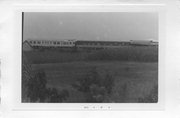| Additional Information: | A 'site file' exists for this property. It contains additional information such as correspondence, newspaper clippings, or historical information. It is a public record and may be viewed in person at the Wisconsin Historical Society, State Historic Preservation Office.
FRAME PAVILION W/2 RR CARS ATTACHED.
In 1971 or 1972, Dr. Raymond and Jean Thurow purchased an opulent vintage train car called the "Burlington 100" or "1914" so named for the year the car was built for Arthur Curtis James, an executive of the Phelps Dodge Co., a copper mining firm, as well as the El Paso and South Western Railroad. The custom-built car, which also served as an observation area and was always placed at the rear of the train, featured a huge conference room with mahogany woodwork inlaid with a lighter species that was situated at the far end of the car. Adjacent to this room, which was equipped with easy chairs and three telephones, was a room for the secretary followed by two staterooms, each with a brass bed and smaller upper berths, a toilet, three mirrors and access to a stainless steel shower. Next came a dining room with a table large enough to seat ten or twelve people, and after that a bathroom with a tub and toilet. The far end of the car was reserved for the porter and included a kitchen area with stove, refrigerator, charcoal broiler plus efficient storage for china and cutlery plus pots and pans. When James became a director of the Burlington Railroad, he took the car, which had originally cost about $50,000 (or the equivalent of $850,000 in 1971) with him. In 1939, the car was updated for air conditioning and used until it was finally retired in 1970.
The Thurows also purchased a newer Pullman railroad car, and both cars were transported on the regular rail lines (now part of the bike patch) to Riley, and from there they were moved to their final hilltop location by the Reynolds Moving Company of Madison using a truck normally used to carry transformers and similar heavy items. Once installed on newly laid tracks, the train cars were used the the Thurows for guests, storage, and as a meeting room. The couple then erected a two-story multi (eleven) sided house with a breezeway that connected the residential component, which may have been a prefab or pre-cut design. |
|---|

